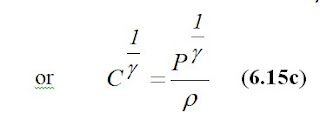This method is based in the phenomenon that a stream of fluid (liquid, gas or vapour) when passing through the restriction or primary device (orifice plate, Venturi plate, flow nozzle, etc.) is subjected to the change of kinetic and potential energy of the stream during variations of flowrate. Figure 6.1 shows an orifice plate.
Let’s consider two cases with incompressible and compressible fluids.
Case 1. Incompressible fluid.
The following
assumptions should be considered when derive working equations:
1 - fluid is incompressible, and there are no phase changes when fluid passes through the orifice;
2 - fluid flow is steady and frictionless, ie. there are no energy losses due to friction;
3 - flow is isothermal, ie. no heat losses or gains due to heat transfer between the fluid and its surroundings;
4 - there is no in and outflow of energy between sections A - A and B - B;
5 - mass flowrates in each cross-section of the stream is constant;
6 - pipe is horizontal.
Figure 6.1. Orifice plate.
(from Bentley J. P. Principles of Measurement Systems, Longman, 1995, p. 286): An equation for conservation of mass flowrate is as follows:

(6.1)
Since

(6.2)
then, we can give an equation for conservation of volumetric flowrate

(6.3)
When a volumetric flow rate in a pipe (see Figure 6.2) increases, then the velocity of the fluid through the orifice should increase as well. Since
SA>SB , then
vA<vB. Due to inertia the smallest cross-section area of the stream is not in the plane of the orifice itself, but some distance downstream from it. The total energy of the stream is equal to the sum of its kinetic energy and static head of the stream.
Figure 6.2. Orifice-type differential pressure flowmeter.
Since the kinetic energy increases (due to the increasing of the velocity of the stream in cross-section B - B), then the static head should decrease. This static head is responsible for the static pressure of the stream. Therefore, there is a head difference in two cross-sections (ΔP=PA-PB), namely the differential pressure, which is the function of the velocity and finally of the flowrate of the stream. It means that for each value of the flowrate corresponds a certain value of a differential pressure. Therefore, we can measure this differential pressure and, finally, evaluate the required value of the flowrate.
Equations for potential and kinetic energies of the fluid stream and work performed by it are as follows
(from Bentley J. P. Principles of Measurement Systems, Longman, 1995, p. 280):
Combine equations
(6.4) - (6.5) and get an equation for the conservation of the total energy per unit mass of the stream for the case of two cross-sections
A - A and
B - B:

(6.7)
or, since the pipe is horizontal (the assumption 6)
then

From equation (6.9) we can get an expression for the velocity of the stream in the cross-section
B - B:
A theoretical equation for the flow of a fluid is as follows:

(6.12)
Frictionless flow is only approached at well-established turbulent flows. We are not able to measure
SAand
SB, which vary with the variation of fluid flowrate. So, we need to modify equation (6.12) and get a practical equation for the evaluation of fluid volumetric flowrate:

(6.13)
In the above equations we used the following parameters:
Case 2. Compressible fluid.
In this case the density of a fluid depends on pressure in the form (from Bentley J. P. Principles of Measurement Systems, Longman, 1995, p. 287):
From (6.14) we have:
Let’s integrate an expression

Then:
Now we can re-write Bernoulli equation in the following form:

(6.16)
or, since
zA=zB then,

(6.17)
During the flow of a compressible fluid we have:
 (6.18)
(6.18)
and therefore,
 (6.19)
(6.19)
So,

(6.20)
and

(6.21)
Therefore, mass flowrate is used in gas metering. A theoretical equation for a compressible flow has the following form:

(6.22)
A practical equation for a compressible flow has the following form:

(6.23)
where, the expansibility factor has the following form according to
BS 1041 and
ISO 5167 (from Bentley J. P. Principles of Measurement Systems, Longman, 1995, p. 288):

(6.24)
For liquids ꜫ
=1.0
Below are given equations and data, which should be used during calculations of flowrates when orifice plates are used.
Discharge coefficient data for orifice plate, BS 1042.
The Stolz equation:

(6.25)
If

(6.26)
then,

(6.27)
For corner tappings:

(6.28)
For flange tappings:

(6.29)
a). Conditions of validity for corner taps:
b). Conditions of validity for flange taps:
To calculate the value of D
or one need to perform several iterations until this value is obtained with the accuracy equal to the tolerance
δ of machining of the surface of an orifice.
Step 1. Calculate Re.
Step 2. Set initial guess for parameters as follows:
C=0.6, ꜫ =1.0 , E=1.0Step 3. Calculate area
Sor of the orifice hole using (6.13) or (6.23) and value of maximum flowrate.
Step 4. Calculate
Dor.Step 5. Calculate
β.Step 6. Revise the value of
E according to

Step 7. If we have liquid, then
ꜫ =1.0. Evaluate
C according to (6.25). Then continue starting from step 3, and so on.
Step 8. If we have gas, then if

evaluate
ꜫ according to (6.24). Evaluate
C according to (6.25). Then continue starting from step 3, and so on.
Step 9. Check if
Dor. >=12.5mm .
Step 10. Check if final values of
β and
Re are within limits.
 (6.47)
(6.47) , therefore,
, therefore, (6.49)
(6.49)






































































